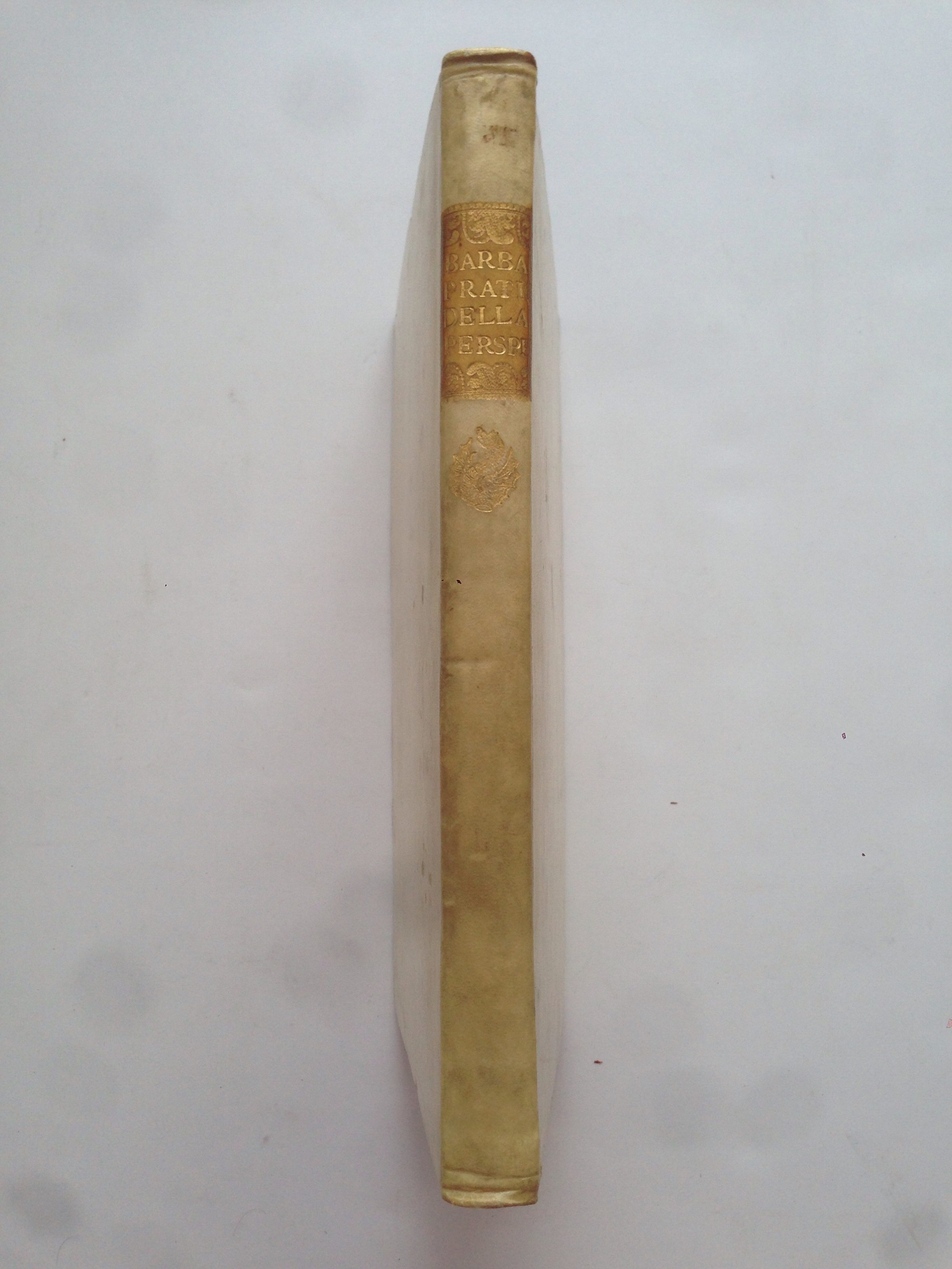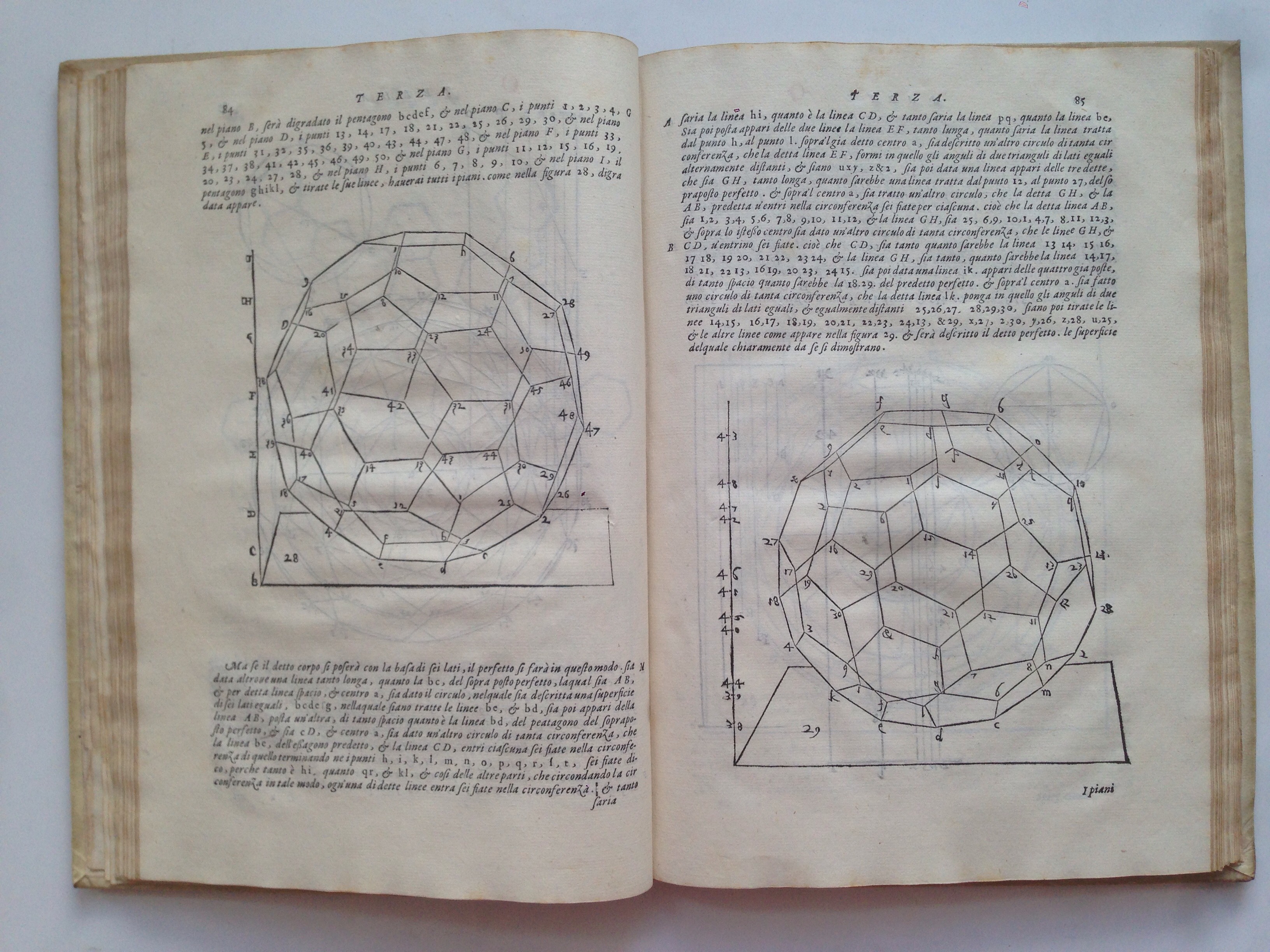BARBARO, Daniello
La pratica della perspettiua ... opera molto vtile a pittori, a scultori, & ad architetti
Venice, appresso Camillo, & Rutilio Borgominieri fratelli, al segno di S. Giorgio, 1568£9,750.00
FIRST EDITION first issue [Both title and colophon with date 1568]. Folio. pp. 195. [xiii]. A-O , P , Q-2A , 2B . Italic letter. Title with “Borgomineri Brother’s device of the serpent-wreathed staff, … the first two words of title are set within a cartouche with grotesque heads and trophies of captives of war….Two hundred woodcuts, the majority being diagrams. These include twenty-two full pages, .. one double page, .. and one plate at the end. The final plate is an illustration of a new measuring instrument by Giacomo Fusto Castriotto, on the recto of leaf Aa4, verso blank. On leaves T4v-V1v are three blocks of theater scenes from Francesco de Franceschi’s 1566 edition of Serlio, dedicated to Barbaro…. The block on leaf T3r is also from Franceschi. The woodcut on leaf Aa2r, showing two men using a drawing instrument to copy a lute, is a free copy of Albrect Durer’s woodcut dated 1525, which appears at the end of his Underweysung der messung, Nuremburg, 1525. Other Durer illustrations from the messung and Von menschlicher Proportione .. were adapted by Barbaro for this volume. The errata on leaves Bb5v-Bb6v include corrections to the illustrations. Ten large headpieces in geometric forms, designed for this volume, one for each of the nine parts and the index. .. Two pieces of foliated ornament with grotesque heads. Type ornaments. Historiated and foliated initials in two sizes. The serpent wreathed staff device from first title page is repeated on leaf of Bb6v.”. Mortimer, Harvard Italian 39. Early stamp on title, bookplate of Gianni de Marco on pastedown. Light ink or water-stain mostly to margins of a few leaves, rare marginal brown spot, or minor stain, blank upper portion of last leaf with a few tears, backed on verso just touching printer’s device. A good copy, crisp and clean, with good impression of the woodcuts, in Italian C18th vellum over boards, title gilt lettered on spine, with dragon fleuron below, a.e.g.
Rare first edition, first issue ,of Barbaro’s important treatise on perspective; it can also be composed of titles and colophons dated 1568 and 1569 in any combination, another variant has an elaborate woodcut title with no date. The Venetian Daniel Barbaro (1514-1570) advocated the use of the camera obscura as an aid to drawing and perspective, and this work contains one of the earliest descriptions of the use of a biconvex lens to assist artists in the representation of scenes from nature, bringing the device one step closer to the modern-day camera. The improvement in the image obtained with the device, as well as by adjusting the distance upon which the image is to be projected, was described by Barbaro. This work was one of the most respected texts on perspective in the sixteenth century, comparable to Durer’s Manual. Designed for an audience of artists, architects, stage designers, etc., Barbaro’s work is more mathematical than artistic. Its influence derived from the separation of perspective, used in the design of stage sets, from the graphic representation of buildings. It is partly based on the methods and writings of Piero della Francesca, but written in a more readable and humanistic style. The work is illustrated in part with a range of polyhedra, and it includes the earliest drawing of the truncated icosidodecahedron and it ties Jamnitzer for the earliest rhombicosidodecahedron. The work opens with a preparatory text on the principles of geometrical optics, the division of surfaces, the properties of triangles and the distinction between point at the level of the eye and the distance point. The sixth part is the account and the reduction of the diagram of Ptolomy’s planisphere.
“The treatise on practical perspective by the Venetian humanist Daniele Barbaro was the first work of its type published in Italy. .. In his annotations on Vitruvius’ treatise (1567), Barbaro had already devoted a long passage to the question. … He learned perspective with the mathematician Giovanni Zamberti, the brother of Bartolomeo, the celebrated translator of Euclid. From contact with him, he became initiated into the questions of geometric optics which make up the starting point of his treatise. But he extends the universe of scientific reference considerably for problems of figurative standardization. The questions raised by Ptolemy’s planisphere entered into debates on perspective in the second half of the 16th century, thanks to Federico Commandino’s annotations (1558). … Barbaro’s treatise on perspective is the first text which attempted to bring together in a single book subject matter which until then had been dispersed in works from numerous, sometimes unrelated, disciplines, and of very different status. He expresses remarkable skill in reformulating speculations and giving them a function clearly and briefly. Thus Barbaro’s treatise constitutes the first reduction in the art of perspective, a model which was to be traditional until the 19th century.” Pascal Dubourg-Glatigny. A crisp copy of this important and beautifully illustrated work.
BM STC Fr. C16th p. 70. Adams B-171. Mortimer Italian 39. Berlin Kat. 4694. Brunet I, 644. Cicognara 809. Fowler 36. Gamba 1233.In stock












